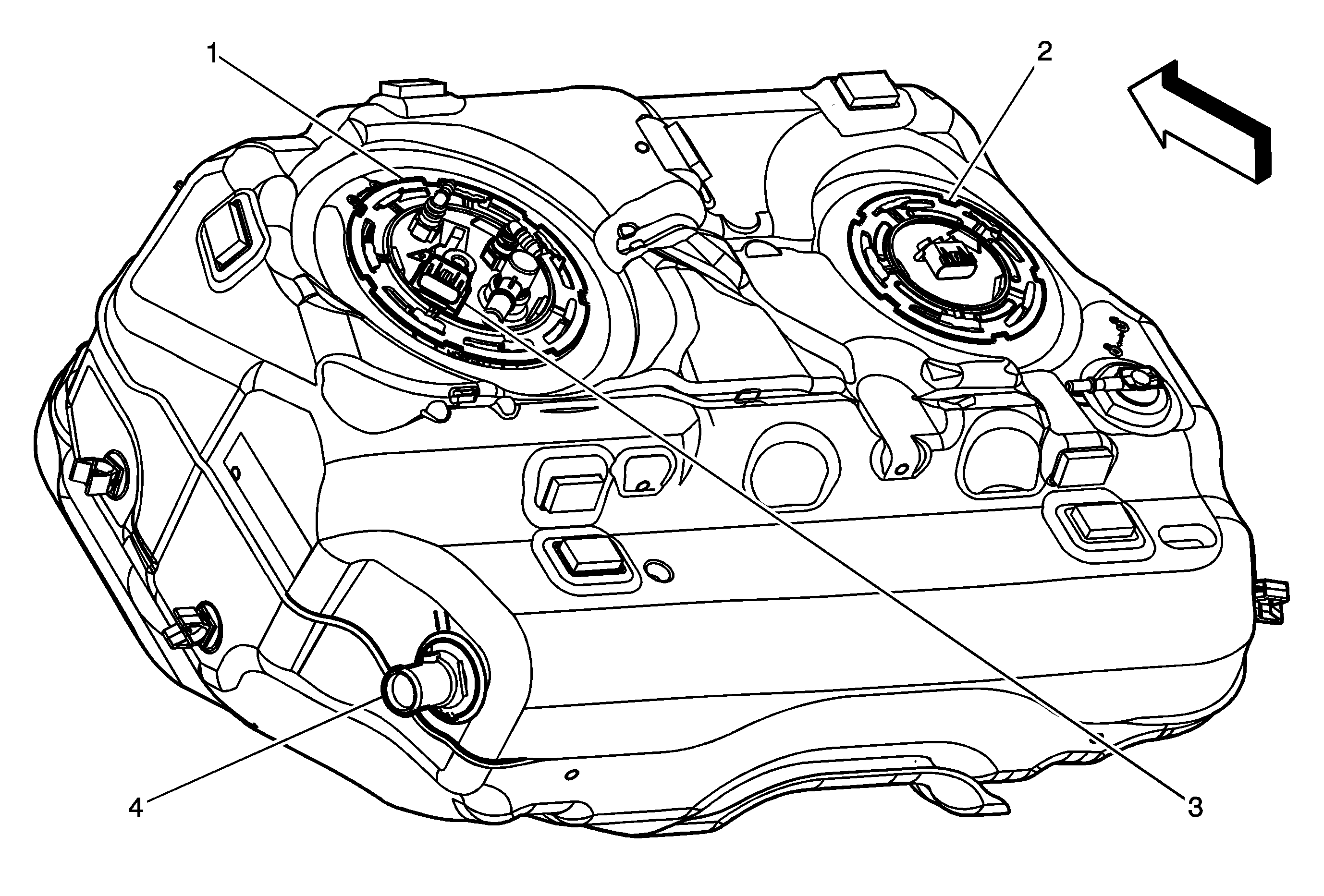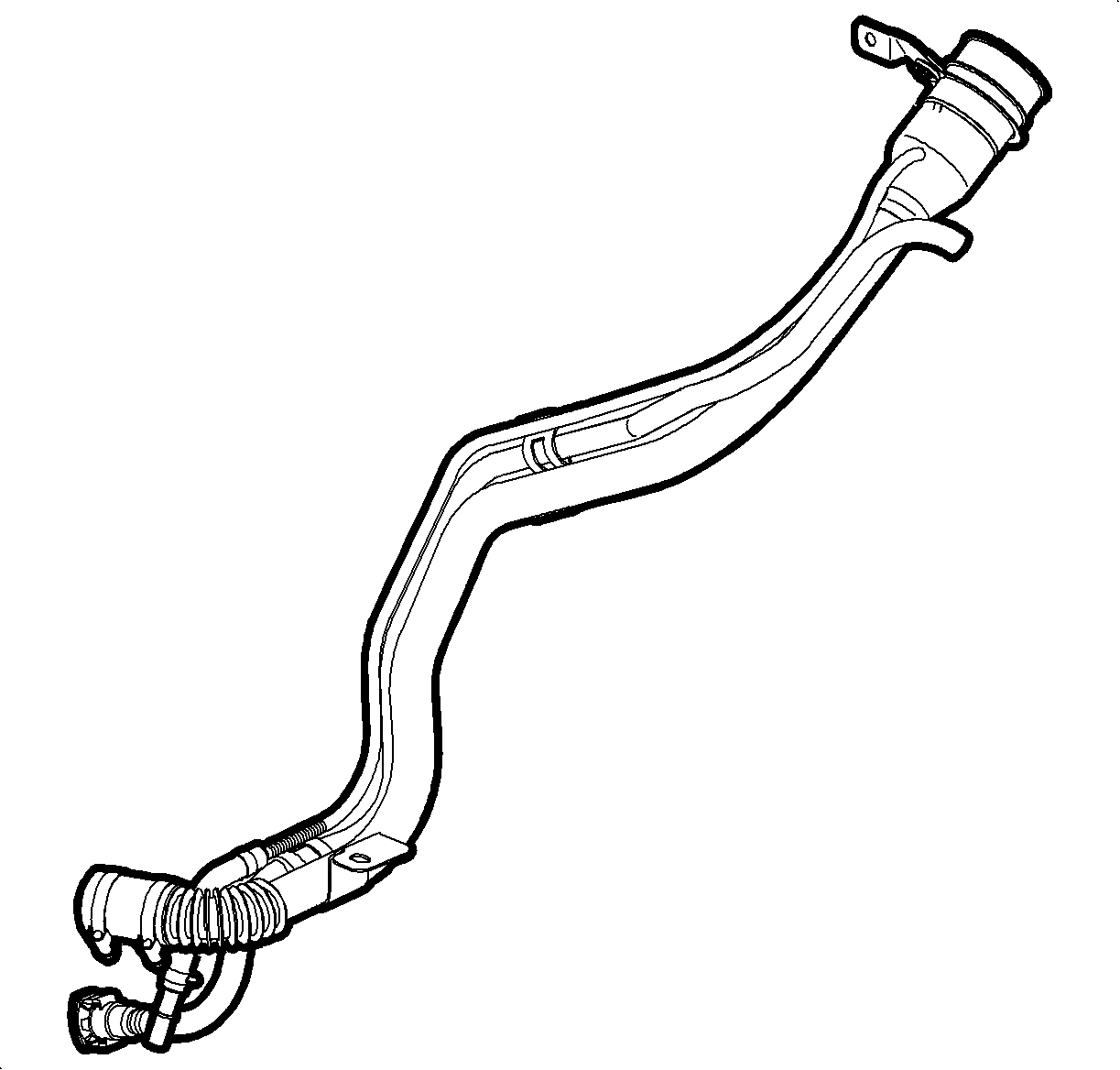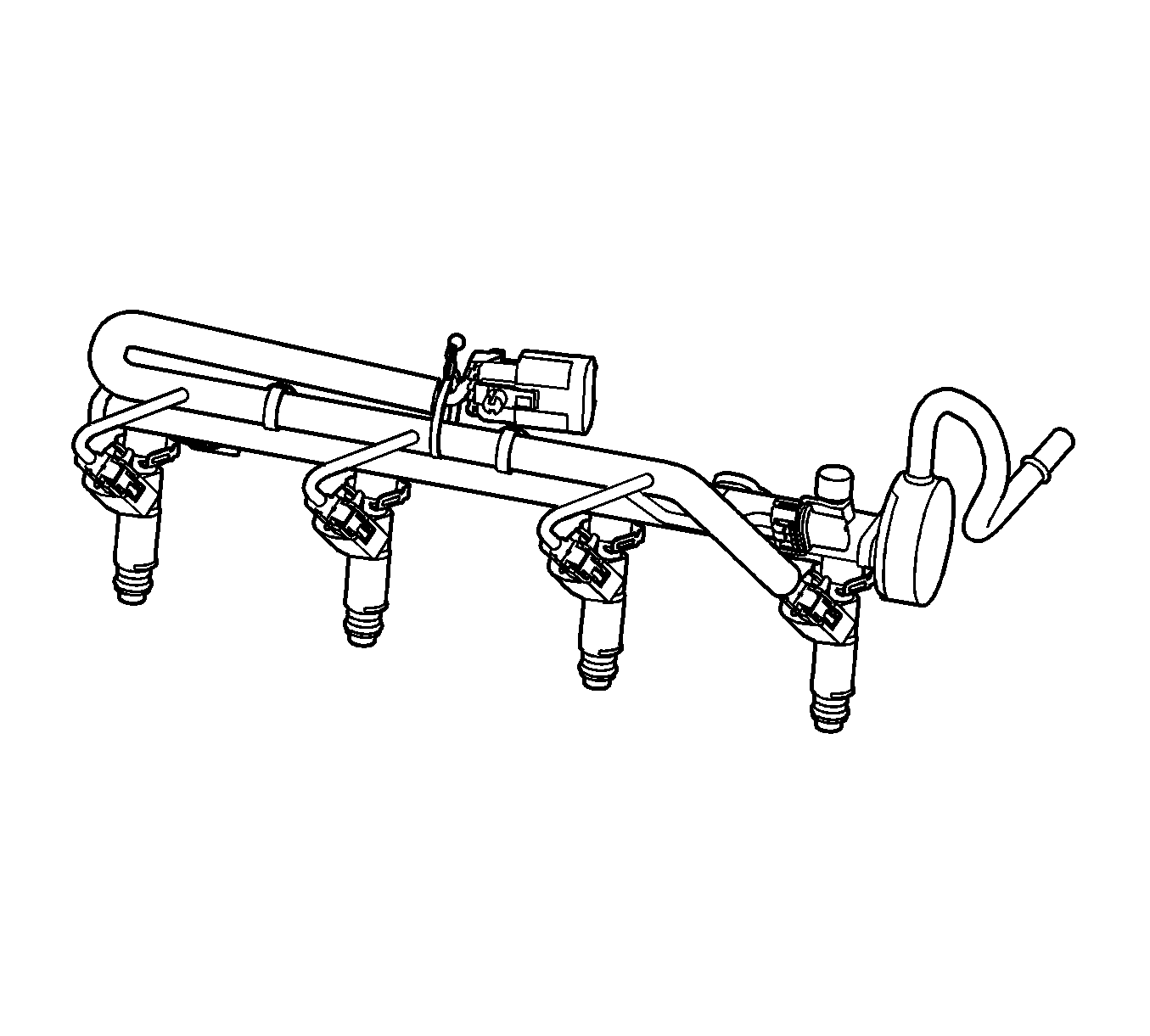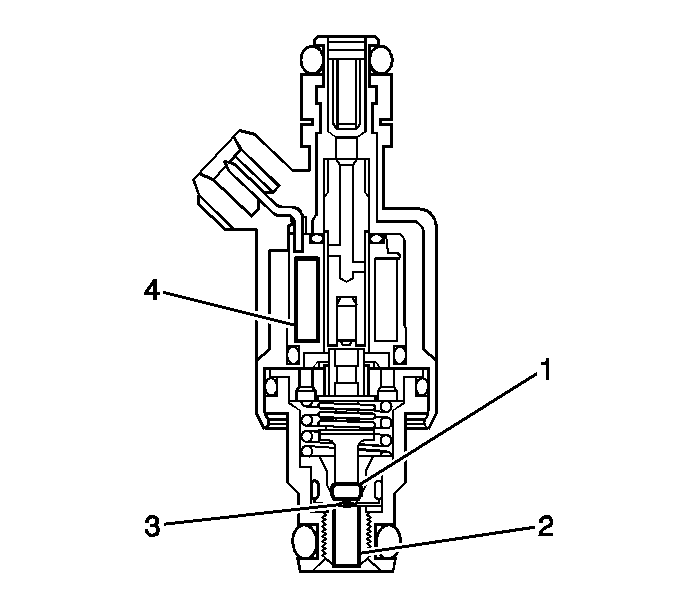Fuel System Overview
The fuel system is an electronic returnless on-demand design. A returnless fuel system reduces the internal temperature of the fuel tank by not returning hot fuel from the engine to the fuel tank. Reducing the internal temperature of the fuel tank results in lower evaporative emissions.
An electric turbine style fuel pump attaches to the primary fuel tank module inside the fuel tank. The fuel pump supplies high pressure fuel through the fuel filter and the fuel feed pipe to the fuel injection system. The primary fuel tank module contains a reverse flow check valve. The check valve maintains fuel pressure in the fuel feed pipe and the fuel rail in order to prevent long cranking times.
The primary fuel tank module also contains a primary jet pump and a secondary jet pump. Fuel pump flow loss, caused by vapor expulsion in the pump inlet chamber, is diverted to the primary jet pump and the secondary jet pump through a restrictive orifice located on the pump cover. The primary jet pump fills the reservoir of the primary fuel tank module. The secondary jet pump creates a venturi action which causes the fuel to be drawn from the secondary side of the fuel tank, through the fuel transfer pipe, to the primary side of the fuel tank.
Electronic Returnless Fuel System (ERFS)
The electronic returnless fuel system is a microprocessor controlled fuel delivery system which transports fuel from the tank to the fuel rail. It functions as an electronic replacement for a traditional, mechanical fuel pressure regulator. A pressure relief regulator valve within the fuel tank provides an added measure of over pressure protection. Desired fuel pressure is commanded by the engine control module (ECM), and transmitted to the fuel pump flow control module (FPCM) via a GMLAN serial data message. A liquid fuel pressure sensor provides the feedback the FPCM requires for Closed Loop fuel pressure control.
Fuel Pump Flow Control Module (FPCM)
The fuel pump flow control module (FPCM) is a serviceable GMLAN module. The FPCM receives the desired fuel pressure message from the engine control module (ECM) and controls the fuel pump located within the fuel tank to achieve the desired fuel pressure. The FPCM sends a 25 KHZ PWM signal to the fuel pump, and pump speed is changed by varying the duty cycle of this signal. Maximum current supplied to the fuel pump is 15 amps. A liquid fuel pressure sensor provides fuel pressure feedback to the FPCM.
Fuel Pressure Sensor
The fuel pressure sensor is a serviceable 5-volt, 3-pin device. It is located on the fuel feed line forward of the fuel tank, and receives power and ground from the fuel pump flow control module (FPCM) through a vehicle wiring harness. The sensor provides a fuel pressure signal to the FPCM, which is used to provide Closed Loop fuel pressure control.
Fuel Tank

The fuel tank stores the fuel supply. The fuel tank is located in the rear of the vehicle. The fuel tank is held in place by 2 metal straps that attach to the under body of the vehicle. The fuel tank is molded from high-density polyethylene.
In order to provide space for a driveshaft though the center area of the tank, the fuel tank is a saddle configuration. Because of the saddle shape of the tank two fuel tank modules are required. The primary fuel tank module (1) is located on the left side of the tank. The secondary fuel tank module (2) is located on the right side of the tank.
Fuel Fill Pipe

The fuel fill pipe has a built-in restrictor in order to prevent refueling with leaded fuel.
Fuel Filler Cap
Caution: If a fuel tank filler cap requires replacement, use only a fuel tank filler cap with the same features. Failure to use the correct fuel tank filler cap can result in a serious malfunction of the fuel and EVAP system.
The fuel fill pipe has a tethered fuel filler cap. A torque-limiting device prevents the cap from being over-tightened. To install the cap, turn the cap clockwise until you hear audible clicks. This indicates that the cap is correctly torqued and fully seated. A fuel filler cap that is not fully seated may cause a malfunction in the emission system.
Primary Fuel Tank Module
The primary fuel tank module is located inside of the left side of the fuel tank. The primary fuel tank module consists of the following major components:
| • | The fuel level sensor |
| • | The fuel pump and reservoir assembly |
| • | The pressure relief regulator valve |
| • | The fuel strainer |
| • | The primary jet pump |
| • | The secondary jet pump |
| • | The fill limit vent valve |
| • | The fuel tank pressure (FTP) sensor |
| • | The fuel filter |
| • | The fuel transfer pipe |
Secondary Fuel Tank Module
The secondary fuel tank module is located inside of the right side of the fuel tank. The secondary fuel tank module consists of the following major components:
| • | The fuel level sensor |
| • | The fuel pick-up |
Fuel Level Sensor
The fuel level sensor consists of a float, a wire float arm, and a ceramic resistor card. The position of the float arm indicates the fuel level. The fuel level sensor contains a variable resistor which changes resistance in correspondence with the position of the float arm. The engine control module (ECM) monitors the signal circuits of the primary fuel level sensor and the secondary fuel level sensor in order to determine the fuel level. When the fuel tank is full, the resistance of both fuel level sensors are low and the ECM senses a low signal voltage on both the signal circuits of the primary fuel level sensor and the secondary fuel level sensor. When the fuel tanks are empty, the resistances of the fuel level sensors are high and the ECM senses a high signal voltage. The ECM uses the signal circuits of the primary fuel level sensor and the secondary fuel level sensor in order to calculate the percentage of remaining fuel in the tank. The ECM sends the fuel level percentage via serial data circuit to the instrument cluster in order to control the fuel gage.
Fuel Pump
The fuel pump is mounted in the primary fuel tank module reservoir. The fuel pump is an electric high-pressure pump. Fuel is pumped to the fuel injection system at a pressure that is based on feedback from the fuel pressure sensor. The fuel pump delivers a constant flow of fuel to the engine even during low fuel conditions and aggressive vehicle maneuvers.
Pressure Relief Regulator Valve
The pressure relief regulator valve replaces the typical fuel pressure regulator used on a mechanical returnless fuel system. The pressure relief regulator valve is closed during normal vehicle operation. The pressure relief regulator valve is used to vent pressure during hot soaks and also functions as a fuel pressure regulator in the event of the fuel pump flow control module defaulting to 100 percent pulse width modulation (PWM) of the fuel pump. Due to variation in fuel system pressures, the opening pressure for the pressure relief regulator valve is set higher than the pressure that is used on a mechanical returnless fuel system pressure regulator.
Primary and Secondary Jet Pumps
The primary jet pump is located in the primary fuel tank module. Fuel pump flow loss, caused by vapor expulsion in the pump inlet chamber, is diverted to the primary jet pump and the secondary jet pump through a restrictive orifice located on the pump cover. The primary jet pump fills the reservoir of the primary fuel tank module.
The secondary jet pump creates a venturi action which causes the fuel to be drawn from the secondary side of the fuel tank, through the transfer pipe, to the primary side of the fuel tank.
Fuel Strainer
The fuel strainer attaches to the lower end of the primary fuel tank module. The fuel strainer is made of woven plastic. The functions of the fuel strainer are to filter contaminants and to wick fuel. The fuel strainer normally requires no maintenance. Fuel stoppage at this point indicates that the fuel tank contains an abnormal amount of sediment or contamination.
Fuel Filter
The fuel filter is located in the primary fuel tank module. The paper filter element traps particles in the fuel that may damage the fuel injection system. The filter housing is made to withstand maximum fuel system pressure, exposure to fuel additives, and changes in temperature.
Fuel Feed Pipes
The fuel feed pipe carries fuel from the fuel tank to the fuel injection system. The fuel pipe consists of 2 sections:
| • | The rear fuel pipe is located from the top of the fuel tank to the chassis fuel pipe. The rear fuel pipe is constructed of nylon. |
| • | The chassis fuel pipe is located under the vehicle and connects the rear fuel pipe to the fuel rail. The chassis fuel pipe is constructed of steel with a section of rubber hose. |
Nylon Fuel Pipes
Warning: In order to reduce the risk of fire and personal injury observe the following items:
• Replace all nylon fuel pipes that are nicked, scratched or damaged during installation, do not attempt to repair the sections of the nylon fuel pipes • Do not hammer directly on the fuel harness body clips when installing new fuel pipes. Damage to the nylon pipes may result in a fuel leak. • Always cover nylon vapor pipes with a wet towel before using a torch near them. Also, never expose the vehicle to temperatures higher than 115°C (239°F) for more than one hour, or more than 90°C (194°F) for any extended period. • Apply a few drops of clean engine oil to the male pipe ends before connecting fuel pipe fittings. This will ensure proper reconnection and prevent a possible fuel leak. (During normal operation, the O-rings located in the female connector will swell
and may prevent proper reconnection if not lubricated.)
Nylon pipes are constructed to withstand maximum fuel system pressure, exposure to fuel additives, and changes in temperature.
Heat resistant rubber hose or corrugated plastic conduit protect the sections of the pipes that are exposed to chafing, high temperature, or vibration.
Nylon fuel pipes are somewhat flexible and can be formed around gradual turns under the vehicle. However, if nylon fuel pipes are forced into sharp bends, the pipes kink and restrict the fuel flow. Also, once exposed to fuel, nylon pipes may become stiffer and are more likely to kink if bent too far. Take special care when working on a vehicle with nylon fuel pipes.
Quick-Connect Fittings
Quick-connect fittings provide a simplified means of installing and connecting fuel system components. The fittings consist of a unique female connector and a compatible male pipe end. O-rings, located inside the female connector, provide the fuel seal. Integral locking tabs inside the female connector hold the fittings together.
Fuel Rail Assembly

The fuel rail assembly attaches to the cylinder head. The fuel rail assembly performs the following functions:
| • | Positions the injectors in the intake ports of the cylinder head |
| • | Distributes fuel evenly to the injectors |
| • | Integrates the fuel pulse dampener into the fuel metering system |
Fuel Injectors

The fuel injector assembly is a solenoid device controlled by the control module that meters pressurized fuel to a single engine cylinder. The control module energizes the high-impedance, 12 ohm, injector solenoid (4) to open a normally closed ball valve (1). This allows fuel to flow into the top of the injector, past the ball valve, and through a director plate (3) at the injector outlet. The director plate has machined holes that control the fuel flow, generating a spray of finely atomized fuel at the injector tip. Fuel from the injector tip is directed at the intake valve, causing the fuel to become further atomized and vaporized before entering the combustion chamber. This fine atomization improves fuel economy and emissions.
Fuel Pulse Dampener
The rapid opening and closing of the fuel injectors cause pressure fluctuation in the fuel rail. The result is that the amount of injected fuel will be more or less than the desired amount. Mounted on the fuel rail, the pulsation damper reduces these pressure fluctuations. When pressure suddenly begins to drop, the spring-loaded diaphragm extends slightly decreasing fuel rail volume. This will momentarily prevent fuel pressure from becoming too low.
Fuel Metering Modes of Operation
The ECM monitors voltages from several sensors in order to determine how much fuel to give the engine. The ECM controls the amount of fuel delivered to the engine by changing the fuel injector pulse width. The fuel is delivered under one of several modes.
Starting Mode
The ECM supplies a high voltage signal to the fuel pump control module (FPCM) when the ECM detects that the ignition is ON. The high voltage signal from the ECM to the FPCM remains active for two seconds, unless the engine is in Crank or Run. While this signal is being received, the FPCM closes the ground switch of the fuel pump and also supplies a varying voltage to the fuel tank pump module in order to maintain the desired fuel rail pressure. The ECM calculates the air/fuel ratio based on inputs from the engine coolant temperature (ECT), manifold absolute pressure (MAP), and throttle position (TP) sensors. The system stays in starting mode until the engine speed reaches a predetermined RPM.
Clear Flood Mode
If the engine floods, clear the engine by pressing the accelerator pedal down to the floor and then crank the engine. When the TP sensor is at wide open throttle (WOT), the ECM reduces the fuel injector pulse width in order to increase the air to fuel ratio. The ECM holds this injector rate as long as the throttle stays wide open and the engine speed is below a predetermined RPM. If the throttle is not held wide open, the ECM returns to the starting mode.
Run Mode
The run mode has 2 conditions called Open Loop and Closed Loop. When the engine is first started and the engine speed is above a predetermined RPM, the system begins Open Loop operation. The ECM ignores the signal from the heated oxygen sensor (HO2S). The ECM calculates the air/fuel ratio based on inputs from the engine coolant temperature (ECT), manifold absolute pressure (MAP), and TP sensors. The system stays in Open Loop until meeting the following conditions:
| • | The HO2S has varying voltage output, showing that the HO2S is hot enough to operate properly. |
| • | The ECT sensor is above a specified temperature. |
| • | A specific amount of time has elapsed after starting the engine. |
Specific values for the above conditions exist for this engine, and are stored in the electrically erasable programmable read-only memory (EEPROM). The system begins Closed Loop operation after reaching these values. In Closed Loop, the ECM calculates the air/fuel ratio, injector ON time, based upon the signal from various sensors, but mainly from the HO2S. This allows the air/fuel ratio to stay very close to 14.7:1.
Acceleration Mode
When the driver pushes on the accelerator pedal, air flow into the cylinders increases rapidly. To prevent possible hesitation, the ECM increases the pulse width to the injectors to provide extra fuel during acceleration. This is also known as power enrichment. The ECM determines the amount of fuel required based upon the TP, the engine coolant temperature (ECT), the manifold absolute pressure (MAP), and the engine speed.
Deceleration Mode
When the driver releases the accelerator pedal, air flow into the engine is reduced. The ECM monitors the corresponding changes in the TP and the manifold absolute pressure (MAP). The ECM shuts OFF fuel completely if the deceleration is very rapid, or for long periods, such as long, closed-throttle coast-down. The fuel shuts OFF in order to prevent damage to the catalytic converters.
Battery Voltage Correction Mode
When the battery voltage is low, the ECM compensates for the weak spark delivered by the ignition system in the following ways:
| • | Increasing the amount of fuel delivered |
| • | Increasing the idle RPM |
| • | Increasing the ignition dwell time |
Fuel Cutoff Mode
The ECM cuts OFF fuel from the fuel injectors when the following conditions are met in order to protect the powertrain from damage and improve driveability:
| • | The ignition is OFF. This prevents engine run-on. |
| • | The ignition is ON but there is no ignition reference signal. This prevents flooding or backfiring. |
| • | The engine speed is too high, above red line. |
| • | The vehicle speed is too high, above rated tire speed. |
| • | During an extended, high speed, closed throttle coast down--This reduces emissions and increases engine braking. |
| • | During extended deceleration, in order to prevent damage to the catalytic converters |
Fuel Trim
The ECM controls the air/fuel metering system in order to provide the best possible combination of driveability, fuel economy, and emission control. The ECM monitors the heated oxygen sensor (HO2S) signal voltage while in Closed Loop and regulates the fuel delivery by adjusting the pulse width of the injectors based on this signal. The ideal fuel trim (FT) values are around 0 percent for both short and long term FT. A positive FT value indicates the ECM is adding fuel in order to compensate for a lean condition by increasing the pulse width. A negative FT value indicates that the ECM is reducing the amount of fuel in order to compensate for a rich condition by decreasing the pulse width. A change made to the fuel delivery changes the long and short term FT values. The short term FT values change rapidly in response to the HO2S signal voltage. These changes fine tune the engine fueling. The long term FT makes coarse adjustments to fueling in order to re-center and restore control to short term FT. A scan tool can be used to monitor the short and long term FT values. The long term FT diagnostic is based on an average of several of the long term speed load learn cells. The ECM selects the cells based on the engine speed and engine load. If the ECM detects an excessively lean or rich condition, the control module will set a FT DTC.
